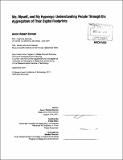| dc.contributor.advisor | Pattie Maes. | en_US |
| dc.contributor.author | Zinman, Aaron Robert | en_US |
| dc.contributor.other | Massachusetts Institute of Technology. Dept. of Architecture. Program in Media Arts and Sciences. | en_US |
| dc.date.accessioned | 2012-03-16T16:04:25Z | |
| dc.date.available | 2012-03-16T16:04:25Z | |
| dc.date.copyright | 2011 | en_US |
| dc.date.issued | 2011 | en_US |
| dc.identifier.uri | http://hdl.handle.net/1721.1/69802 | |
| dc.description | Thesis (Ph. D.)--Massachusetts Institute of Technology, School of Architecture and Planning, Program in Media Arts and Sciences, 2011. | en_US |
| dc.description | Cataloged from PDF version of thesis. | en_US |
| dc.description | Includes bibliographical references (p. 160-172). | en_US |
| dc.description.abstract | Every day, millions of people encounter strangers online. We read their medical advice, buy their products, and ask them out on dates. Yet our views of them are very limited; we see individual communication acts rather than the person(s) as a whole. This thesis contends that socially-focused machine learning and visualization of archived digital footprints can improve the capacity of social media to help form impressions of online strangers. Four original designs are presented that each examine the social fabric of a different existing online world. The designs address unique perspectives on the problem of and opportunities offered by online impression formation. The first work, Is Britney Spears Span?, examines a way of prototyping strangers on first contact by modeling their past behaviors across a social network. Landscape of Words identifies cultural and topical trends in large online publics. Personas is a data portrait that characterizes individuals by collating heterogenous textual artifacts. The final design, Defuse, navigates and visualizes virtual crowds using metrics grounded in sociology. A reflection on these experimental endeavors is also presented, including a formalization of the problem and considerations for future research. A meta-critique by a panel of domain experts completes the discussion. | en_US |
| dc.description.statementofresponsibility | by Aaron Robert Zinman. | en_US |
| dc.format.extent | 193 p. | en_US |
| dc.language.iso | eng | en_US |
| dc.publisher | Massachusetts Institute of Technology | en_US |
| dc.rights | M.I.T. theses are protected by
copyright. They may be viewed from this source for any purpose, but
reproduction or distribution in any format is prohibited without written
permission. See provided URL for inquiries about permission. | en_US |
| dc.rights.uri | http://dspace.mit.edu/handle/1721.1/7582 | en_US |
| dc.subject | Architecture. Program in Media Arts and Sciences. | en_US |
| dc.title | Me, myself, and my hyperego : understanding people through the aggregation of their digital footprints | en_US |
| dc.title.alternative | Understanding people through the aggregation of their digital footprints | en_US |
| dc.type | Thesis | en_US |
| dc.description.degree | Ph.D. | en_US |
| dc.contributor.department | Program in Media Arts and Sciences (Massachusetts Institute of Technology) | |
| dc.identifier.oclc | 777959726 | en_US |
